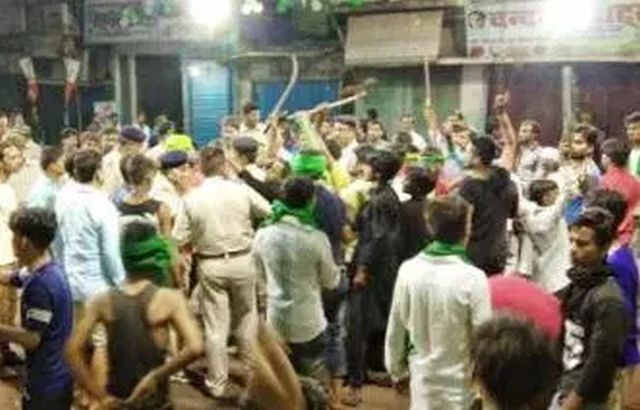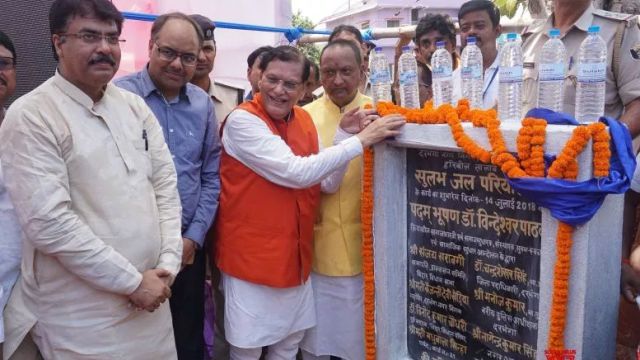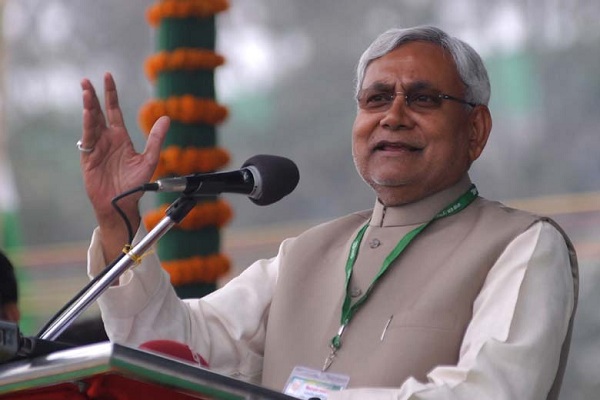
by Editor | May 25, 2021 | Books, Opinions

(Following are excerpts from two chapters – �Highs in Delhi, Lows in Bihar and �The Rising Stars of Bihar Politics of �Gopalganj to Raisina: My Political Journey, a memoir by Lalu Prasad Yadav, President of the Rashtriya Janata Dal, a former Chief Minister of Bihar and former Railways Minister. It is published in English and Hindi by Rupa Publications and is priced at Rs 500. The excerpts are being carried with the permission of the publisher.
HIGHS IN DELHI, LOWS IN BIHAR
I was determined to see the end of the BJP-led government at the Centre, because I believed that both Bihar and the rest of the country had suffered as a consequence of this party’s rise. Central leaders, especially those belonging to Bihar, had been placing obstacle after obstacle in the smooth functioning of the state government under Rabri Devi. Nationally, there was a sense that the oppressed classes as well as the minorities were getting a raw deal. Besides, the BJP had become overconfident, and that had led to arrogance among many of its leaders. It was this mix of overconfidence and arrogance which led the BJP to launch the �India Shining’ campaign. The party was under the illusion that its victory in the 2004 Lok Sabha polls was a mere formality, and that Vajpayee was certain to return to power. I was to play a crucial role in bringing the curtains down on the Vajpayee Government.
It may be recalled that I had helmed a partnership between the RJD and the Congress. My popularity among the people of the state, the tireless efforts of my party workers, the work put in by my allies — all combined to bear fruit. We pulled off a miraculous victory, winning 29 of the 40 Lok Sabha seats in truncated Bihar, after the creation of Jharkhand. The RJD alone secured 22 seats. Paswan’s LJP and the Congress won four and three seats, respectively. The BJP and the Janata Dal (United) — the Samata Party had merged with the JD(U) — had to be content with just six and five seats, respectively.
The poor show of the BJP-led alliance in Bihar contributed significantly to its overall low tally of seats nationwide, leading to its exit from power. I had not only kept the RJD flag flying high at a time when most observers thought that the Vajpayee-led BJP would triumph, but also facilitated the return of the Congress to power after a gap of eight years — its last regime was that of P.V. Narasimha Rao’s, whose tenure ended in 1996.
Perhaps, even more than some Congress leaders, I was eager to make Sonia ji the country’s next prime minister. Over the years, the RJD’s bonds with the Congress had strengthened. At a time when a section of senior Congress leaders was opposed to her leadership, and partners were unsure of their continuance in the Congress camp, the RJD had emerged as the most credible ally of the Congress. The Congress-RJD partnership was — and is — based on a common ideology to promote secularism and save the idea of India, as enshrined in our Constitution.
Months after taking over as Congress president, Sonia Gandhi had successfully contested the Rae Bareli Lok Sabha seat from Uttar Pradesh and debuted in Parliament. The constituency had sentimental value for her; it had been represented by her mother-in-law and former prime minister, Indira Gandhi. Thereafter, in 1999, Sonia Gandhi became the Leader of the Opposition in the Lok Sabha. She had criss-crossed the country, campaigning on the theme of aam aadmi (common man) to blunt the BJP’s India Shining campaign. Despite her relative inexperience in electoral politics, she played a leading role in the Congress’s comeback to power in 2004. I was the backbone of the �common man’ drive; after all, it was this section of society, the aam aadmi, to whose upliftment I had devoted my political career. Sonia ji had surprised not just her opponents, but also many of those from within her party with the seasoned manner in which she led the Congress campaign, overcoming many hurdles along the way, including her �acceptability’ and the language constraints.
Obviously, she was best suited to replace Vajpayee as prime minister. Not surprisingly, the newly-elected Congress MPs unanimously elected her their leader and pitched for her to be the new prime minister. But Sonia ji, in a dramatic manner, refused to accept the mantle. There has been much speculation since then on why she let go of the opportunity. But whatever the reasons, she declined and suggested the name of Dr Manmohan Singh-a veteran economist with vast experience in governance-as her prime ministerial choice. The Congress MPs were deflated, and very reluctantly accepted Dr Singh’s name. Readers will recall the dramatic scenes that were witnessed on the day when Sonia ji declined to become the prime minister. It is not that Congress leaders did not like Dr Singh. They had high regard for him, and they hadn’t forgotten the time when he, as the country’s finance minister in Rao’s government, had turned around the economy, bringing it back from the brink of collapse. However, they had fought the elections under Sonia Gandhi’s leadership and wanted her to lead the country.
While Congress leaders were reconciling to the situation, I was adamant. I had 22 MPs from the RJD, and believed that it would be a personal victory for me if Sonia ji, against whom the NDA had used disrespectful language besides conducting a malicious campaign against me, were to become the prime minister. I was in no mood to accept anyone other than her. Sonia ji called me up first. She insisted on my accepting Dr Singh as the prime minister. I refused. Then, she came to my residence, accompanied by Dr Singh, and sought to reason with me. She even made Dr Singh request me to accept him as the prime minister. I was in a fix. On the one hand, I was hell-bent on seeing her as the new prime minister. On the other hand, I could not turn down her request, more so because she had taken the trouble to visit my residence along with Dr Singh. I finally relented, and Manmohan Singh became the PM. Sonia ji took charge as chairperson of the Congress-led United Progressive Alliance (UPA), which had many parties, including the RJD, as part of the government
DYNASTRY POLITICS: MUCH MALIGNED
With my three children, Misa, Tej Pratap and Tejashwi, becoming active in politics, my opponents began to attack me for promoting what they called dynasty politics. These are baseless and uncalled-for allegations. As parents, we are supposed to help our children in pursuing their passion. Usually, children are influenced by the atmosphere they are born and brought up in. I don’t find anything wrong with the progeny of lawyers, doctors, writers and professors adopting the vocation of their parents. Parents are, after all, duty-bound to help their children pursue the career of their choice. Rabri and I never interfered with Misa when she was doing her MBBS course. We didn’t interfere with Tejashwi’s passion for cricket. Tej Pratap is good at playing the flute, apart from working for the party. They are all adults, doing what they like. We, of course, supported and guided them when they showed an inclination towards politics.
There are several instances in other parties, where leaders have promoted their children in politics. I find nothing wrong with it. I was a poor cowherd’s son. I had not inherited politics from my family. I struggled hard to gain acceptance and recognition from the people. Some elections I won, others I lost. But I never cast aspersions on any of my political opponents for promoting their sons and daughters in politics, even when my children were young and not in politics. In fact, readers will recall, I joined student politics well before I was married to Rabri Devi. Misa was born when I was in jail in 1975. She was barely two years old when I was elected an MP from Chhapra in 1977. My other children were not born then. I don’t believe in the petty politics of attacking my opponents simply because their sons and daughters are in politics. I don’t care if someone attacks me, for I know that my children, after attaining adulthood, have chosen the vocation of their liking.
Moreover, I have promoted hundreds of youth-particularly belonging to the oppressed and minority communities-in politics. More than 60 per cent of the 80 MLAs of our party are new entrants to politics. I have identified fresh political talent among the weaker sections and have guided them. It is not proper to name my peers, but I have given tickets to the sons and daughters of many of my contemporaries to contest elections. We cannot stop change. The new generation is better at connecting with the youth and getting to know their aspirations.
–IANS

by Editor | May 25, 2021 | News

Patna: The opposition Grand Alliance in Bihar on Friday announced the formal allocation of 31 of the total 40 Lok Sabha seats in the state.
Rashtriya Janata Dal (RJD) leader Tejashwi Yadav, speaking at a joint conference here, also announced the names of candidates for 18 of 19 seats the RJD is contesting under the seat sharing plan.
He also named candidates of three seats that the Vikassheel Insan Party (VIP) is contesting.
The Hindustani Awam Morcha (HAM) has already announced its three candidates.
Tejashwi Yadav said that the Congress and Rashtriya Lok Samta Party (RSLP) will announce their candidates soon.
As per the agreement reached by the Grand Alliance, the RJD will contest 20 of the 40 seats in Bihar, the Congress nine while smaller parties have been given the remaining seats.
–IANS

by Editor | May 25, 2021 | News, Politics
 Patna : A youth was killed and another injured in Bihar’s Hajipur on Friday morning by unidentified assailants ahead of the Tazia procession to mark Muharram, police said.
Patna : A youth was killed and another injured in Bihar’s Hajipur on Friday morning by unidentified assailants ahead of the Tazia procession to mark Muharram, police said.
Police Station Officer Incharge Om Prakash said a youth was shot dead near Masjid Chowk and another sustained serious bullet injuries.
Angry over the incident, residents blocked roads, shouted slogans against the state government and staged protests for hours.
The district administration has imposed Section 144 of the Code of Criminal Procedure (CrPC) in Masjid Chowk area, 30km from here. Heavy security forces have been deployed to maintain law and order.
—IANS

by Editor | May 25, 2021 | Corporate, Corporate Governance, News, Politics
 Darbhanga/Patna : An innovative cost-effective drinking water project in Bihar promises to lower the price of one-litre bottle to 50 paise — cheapest in the world.
Darbhanga/Patna : An innovative cost-effective drinking water project in Bihar promises to lower the price of one-litre bottle to 50 paise — cheapest in the world.
The project — Sulabh Jal — was launched on Saturday in Darbhanga by Sulabh International. It will convert contaminated pond water into safe drinking water.
“Sulabh International, an organisation that introduced the concept of ‘Sulabh Shauchalya’ in the country decades ago from Bihar, today (Saturday) laid the foundation stone for an innovative project which will provide cheapest drinking water in the world costing only 50 Paisa per litre,” said a statement from the social service organisation.
“Sulabh Jal will be made available through various stages of purification. It can offer safe drinking water from any water body such as a river or a pond,” it said.
Sulabh International founder Bindeshwar Pathak laid the foundation for the project at Haribol Pond on Darbhanga Nagar Nigam premises.
“The project work will start soon. By December it will be functional,” Pathak said.
Installation of the project would cost around Rs 20 lakh and it would have a capacity to produce 8,000 litres of potable water per day at a nominal cost.
“Local people and NGOs are going to maintain it. It is a self-sustainable project with active participation of the community. It will also generate employment,” he said.
The pilot project in three districts of North 24 Parganas, Murshidabad and Nadia in West Bengal had been jointly established three years ago by Sulabh and a French organisation and the trial run proved successful.
“This is first time in the world that we have succeeded in producing pure drinking water at a very nominal cost using this new technology and villagers would directly benefit from it,” said Pathak.
Groundwater in many parts of Bihar bordering Nepal has been severely affected by arsenic and other chemical contamination.
—IANS





